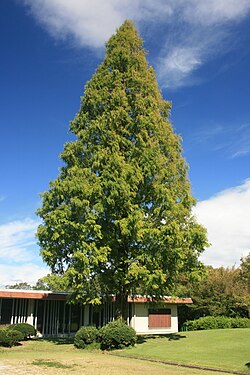I own the oldest specimen of the Metasequia in the Western Hemisphere at 1000 Boxwood Court, Gulph Mills, PA. You are welcome to visit anytime
The previous owner of my home, Robert Dechert, sponsored the expedition to China by the Arnold Arboreatum in 1947 to bring back the Metasequoia glyptostroboides to the Western Hemisphere for the first time in 10 million years!
| Metasequoia glyptostroboides | |
|---|---|
 | |
| Scientific classification | |
| Kingdom: | Plantae |
| Clade: | Tracheophytes |
| Clade: | Gymnospermae |
| Division: | Pinophyta |
| Class: | Pinopsida |
| Order: | Cupressales |
| Family: | Cupressaceae |
| Genus: | Metasequoia |
| Species: | M. glyptostroboides |
| Binomial name | |
| Metasequoia glyptostroboides | |
Metasequoia glyptostroboides, the dawn redwood, is a fast-growing, endangered deciduous conifer. It is the sole living species of the genus Metasequoia, one of three genera in the subfamily Sequoioideae of the family Cupressaceae. It now survives in the wild only in wet lower slopes and montane river and stream valleys in the border region of Hubei and Hunan provinces and Chongqing municipality in south-central China,[2] notably in Lichuan county in Hubei. Although the shortest of the redwoods, it can grow to 167 ft (51 m) in height.[3][2]

In 1941, the genus Metasequoia was reported by paleobotanist Shigeru Miki as a widely distributed extinct genus based on fossils, before attracting considerable attention a few years later when small populations were found alive in central China. It is a well-known example of a living fossil species. Modern dawn redwood appears identical to its late Cretaceous ancestors.[4] The tree faces considerable risks of extinction in its wild range due to deforestation; however, it has been planted extensively in arboreta worldwide, where it has proved a popular and fast-growing ornamental plant. If the species had not been discovered when it was, it might have become extinct before being investigated.[5]
History
[edit]
Although it was commonly known from the fossil record from across the northern hemisphere, the dawn redwood was considered extinct until the mid-twentieth century. When the genus Metasequoia was first described in 1941, it was from Mesozoic Era fossils, none of which were less than 150 million years old. While studying fossil samples of the family Cupressaceae, Dr. Shigeru Miki from Kyoto University identified a divergent leaf form. He realized he had discovered a new genus, which he named Metasequoia, meaning "like a sequoia".[6]
In the same year, Kan Duo (Toh Kan, 1903–1961), professor of Forest Management, National Central University, Chongqing, (formerly Chungking) observed an enormous living specimen while performing a survey in Sichuan and Hubei provinces. Though unaware of Miki's new genus, he recognized the unique traits of the tree. Unfortunately, while he collected some plant material, he did not attempt to identify or publish his findings.[7] This tree formed part of a local shrine, where villagers called it 水杉 (Shuǐshān or "water fir").[8][9] Shuǐshān continues to be the common name of dawn redwood in Chinese.[10]
In 1943, Wang Zhan (Chan Wang, 1911–2000) of the National Bureau of Forest Research, the Ministry of Agriculture and Forests, Chongqing, collected samples from an unidentified tree in the village of Moudao (formerly Motaochi, Maodaoqi or Modaoxi)[11][12] in Lichuan County, Hubei province—now believed to be the same tree Kan discovered.[13] The samples were determined to belong to a tree yet unknown to science, but World War II postponed further study.[citation needed]
Professors Zheng Wanjun (Cheng Wan-Chun) and Hu Xiansu (Hu Hsen-Hsu) made the pivotal connection between Miki's fossil genus and the living samples in 1946,[14] and provided the specific epithet "glyptostroboides", after its resemblance to the Chinese swamp cypress (Glyptostrobus).[15]
In July 1947, the Arnold Arboretum of Harvard University provided $250 to fund an expedition by Zheng Wanjun's assistant Hua Jingchan (Ching-Shan Hwa 1921–present) to collect seeds for the arboretum from the Metasequoia type tree in Moudao, and trees in the nearby Metasequoia Valley (Shuishaba Valley).[5][16] Hua's collecting trip returned with several kilos of seed that were distributed over the next few months for growth trials to Chinese institutions; the Arnold Arboretum, Missouri Botanic Garden, and elsewhere in the United States; botanic gardens at Kew, Edinburgh, and other locations in the United Kingdom; as well as botanic gardens in continental Europe and worldwide.[17]



Comments
Post a Comment